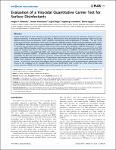Evaluation of a Virucidal Quantitative Carrier Test for Surface Disinfectants
Rabenau, Holger F.
Steinmann, Jochen
Rapp, Ingrid
Schwebke, Ingeborg
Eggers, Maren
Surface disinfectants are part of broader preventive strategies preventing the transmission of bacteria, fungi and viruses in medical institutions. To evaluate their virucidal efficacy, these products must be tested with appropriate model viruses with different physico-chemical properties under conditions representing practical application in hospitals. The aim of this study was to evaluate a quantitative carrier assay. Furthermore, different putative model viruses like adenovirus type 5 (AdV-5) and different animal parvoviruses were evaluated with respect to their tenacity and practicability in laboratory handling. To evaluate the robustness of the method, some of the viruses were tested in parallel in different laboratories in a multi-center study. Different biocides, which are common active ingredients of surface disinfectants, were used in the test. After drying on stainless steel discs as the carrier, model viruses were exposed to different concentrations of three alcohols, peracetic acid (PAA) or glutaraldehyde (GDA), with a fixed exposure time of 5 minutes. Residual virus was determined after treatment by endpoint titration. All parvoviruses exhibited a similar stability with respect to GDA, while AdV-5 was more susceptible. For PAA, the porcine parvovirus was more sensitive than the other parvoviruses, and again, AdV-5 presented a higher susceptibility than the parvoviruses. All parvoviruses were resistant to alcohols, while AdV-5 was only stable when treated with 2-propanol. The analysis of the results of the multi-center study showed a high reproducibility of this test system. In conclusion, two viruses with different physico-chemical properties can be recommended as appropriate model viruses for the evaluation of the virucidal efficacy of surface disinfectants: AdV-5, which has a high clinical impact, and murine parvovirus (MVM) with the highest practicability among the parvoviruses tested.
Dateien zu dieser Publikation
Keine Lizenzangabe

